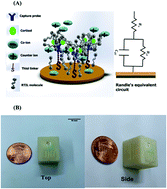Non-invasive monitoring of a circadian relevant biomarker from easily accessible body fluids using hybrid aqueous–ionic buffer interfaces on flexible substrates†
Abstract
Frequent shift work causes disruption of the circadian rhythm and could potentially, in the long run, result in increased health risks. Current biomarkers evaluating the presence of circadian rhythm disturbance include melatonin, cortisol, and body temperature. These require 24 h or “around the clock” measurements, which is tedious. There is an immediate and unmet need to design non-invasive diagnostic sensors for rapid and continuous monitoring of biomarkers associated with circadian rhythm cycles. We have evaluated three biofluids that can enable non-invasive sampling which are sweat, urine and saliva. All the three biofluids have pH variability that typically impacts the sensor performance. In this paper, we demonstrate a hybrid flexible biosensor comprised of an aqueous and ionic interface integrated onto metallic gold microelectrodes for rapid and noninvasive monitoring of cortisol. We show that BMIM[BF4], a room temperature ionic liquid, can be used to modulate pH instability, as well as variations to the ionic content in the aqueous ionic buffers of sweat, urine, and saliva. We have demonstrated the stability of this sensor over the pH range of 4 through 8 in synthetic sweat, saliva, and urine. This detection was tested over a linear dynamic range in the physiologically relevant ranges of cortisol in these bio-fluids. Our facile approach addresses the challenges associated with the variability of body buffer chemistry and its impact on monitoring circadian rhythm.

- This article is part of the themed collection: Electrochemistry for health applications


 Please wait while we load your content...
Please wait while we load your content...